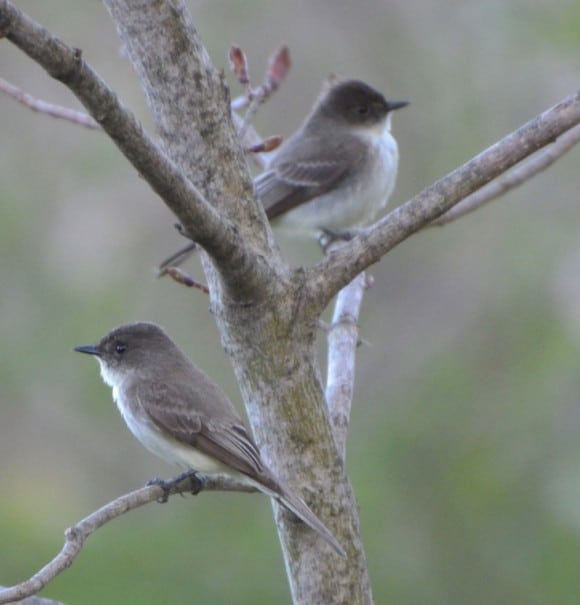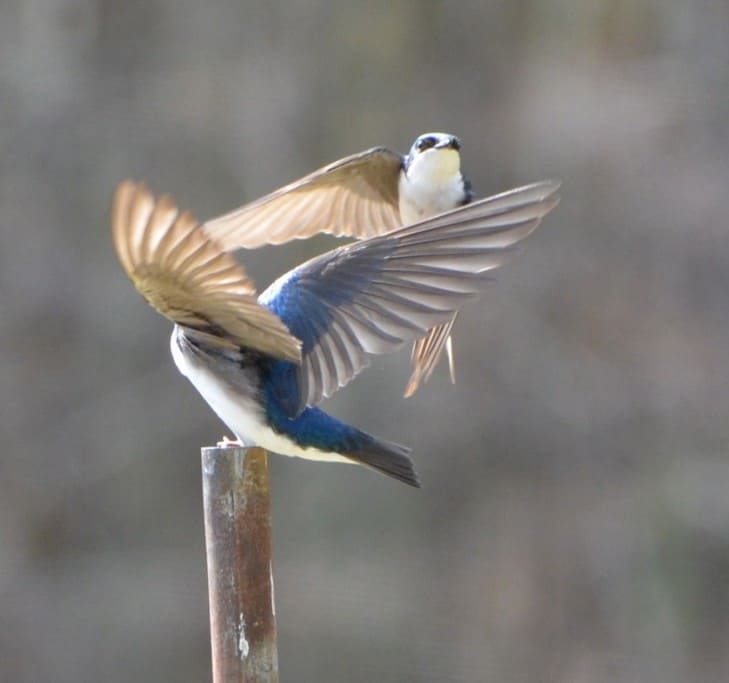It is usually trills and twitters floating through the landscape here at Flower Hill Farm that alerts me to returning warblers and other songbirds.
The earliest seasonal resident to return is the American Woodcock (Scolopax minor) and the male is still flying high each new dawn and dusk, performing his wing-song mating flight.Considered a shore and forest bird, this plump, almond-shaped bird with a long bill is mostly silent, but does twitter with his wings and has an impressive dive to attract a mate.
I have never had the luck to capture a portrait of one. You can see the odd little critter and hear its breath-calls and wing-song.

The Eastern Phoebe (Sayornis phoebe) was very early this year, arriving on March 14th. It is a joy to see the brownish-gray and white songbirds out in the gardens dipping their tails and diving about.

Next to arrive are the Tree Swallows (Tachycineta bicolor.) Three shimmering pairs soar and squabble with each other, and the Bluebirds, over nest boxes most of each day, but they will all settle down soon enough. Their wondrous wing choreography, accompanied by gurgling calls and songs, fills the sky over our farm, fields and forest with a joyous animation. I so appreciate their sweeping the air of biting insects too!
Yellow-rumped Warblers (Setophaga coronata) are adding to the chorus of spring songs and their bright yellow rumps are easy indicators of their identity. April 14th was my first sighting this year of the striking masked warbler.
It was a delight to hear the high pitched notes and chatter of the tiny adult male Ruby-crowned Kinglet (Regulus calendula) in the Crabapple orchard on about April 16th.
It was a real treat having him share his brilliant crown with me, even if only from the back.
A first sighting is ever exciting and so it was with the first capture of a Field Sparrow (Spizella pusilla) at Flower Hill Farm. I enjoy learning a new bird song equally as much as sighting the birds.

Chipping Sparrows (Spizella passerina)have returned as well, and will soon pick a shrub or small tree to shelter their nest. I might confuse their song with that of a Junco, but the dark-eyed gray songbirds, who overwinter here, have all flown to higher ground by now.
All of the songbirds enjoy gleaning the apple trees and shrubs for small caterpillars and bugs and I welcome their help in maintaining our organic farm and wildlife habitat. The many fruiting shrubs and small trees, planted in clusters and hedgerows around the gardens, invite these and many other songbirds into the our daily world. Each day more migrating birds are returning and the songs are becoming more numerous and harder to single out.Just before dawn the sounds are reminiscent of an orchestra, when each instrument is being tuned up . . . playing their own unique melody. The countless warbles and tweets that break with dawn blend together beautifully and are a magical way of celebrating spring and a new season of growth.
flowerhillfarm.blogspot.com
Carol Duke
Carol Duke is an artist and farmer who has worked with the land on a Western Massachusetts hillside for over thirty years. During this time her land has evolved into a diverse wildlife habitat. Carol features the flora and fauna that live and visit her farm on her blog http://flowerhillfarm.blogspot.com/ As vital wildlife habitats are destroyed daily, Carol hopes to inspire others to garden for wildlife, while becoming activists for wild places the world over. Her nature photography has appeared in magazines, books and newspapers.
Leave a Reply